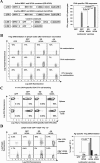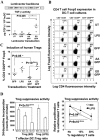Selective ERK activation differentiates mouse and human tolerogenic dendritic cells, expands antigen-specific regulatory T cells, and suppresses experimental inflammatory arthritis
- PMID: 20967853
- PMCID: PMC3040564
- DOI: 10.1002/art.30099
Selective ERK activation differentiates mouse and human tolerogenic dendritic cells, expands antigen-specific regulatory T cells, and suppresses experimental inflammatory arthritis
Abstract
Objective: Most therapeutic treatments for autoimmune arthritis rely on immunosuppressive drugs, which have side effects. Although a previous study by our group showed that specific ERK activation suppressed immune responses, its application in a therapeutic setting has never been tested. The aim of the present study was to define the ERK-dependent immunosuppressive mechanisms and to apply selective ERK activation for the treatment of experimental inflammatory arthritis.
Methods: A constitutively active ERK activator was coexpressed with a model antigen using lentivectors. Immunosuppressive mechanisms were characterized at the level of dendritic cell (DC) function, differentiation of antigen-specific Treg cells, and inhibition of inflammatory T cells. Administration of the ERK activator with antigen as a strategy to suppress inflammatory arthritis was tested in an experimental mouse model.
Results: Selective ERK activation induced mouse and human DCs to secrete bioactive transforming growth factor β, a process required for suppression of T cell responses and differentiation of antigen-specific Treg cells. Treg cells strongly proliferated after antigen reencounter in inflammatory conditions, and these cells exhibited antigen-dependent suppressive activities. Inflammatory arthritis was effectively inhibited through antigen-specific mechanisms. Importantly, this strategy did not rely on identification of the initiating arthritogenic antigen. Equivalent mechanisms were demonstrated in human monocyte-derived DCs, setting the scene for a possible rapid translation of this approach to patients with rheumatoid arthritis.
Conclusion: This strategy of selective ERK activation resulted in an effective therapeutic protocol, with substantial advantages over DC or T cell vaccination.
Copyright © 2011 by the American College of Rheumatology.
Figures






References
-
- Flores-Borja F, Mauri C, Ehrenstein MR. Restoring the balance: harnessing regulatory T cells for therapy in rheumatoid arthritis. Eur J Immunol. 2008;38:934–7. - PubMed
-
- Imperato AK, Bingham CO, III, Abramson SB. Overview of benefit/risk of biological agents. Clin Exp Rheumatol. 2004;22:S108–14. - PubMed
-
- Rutella S, Danese S, Leone G. Tolerogenic dendritic cells: cytokine modulation comes of age. Blood. 2006;108:1435–40. - PubMed
Publication types
MeSH terms
Substances
Grants and funding
LinkOut - more resources
Full Text Sources
Miscellaneous

